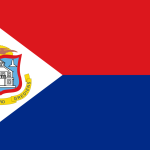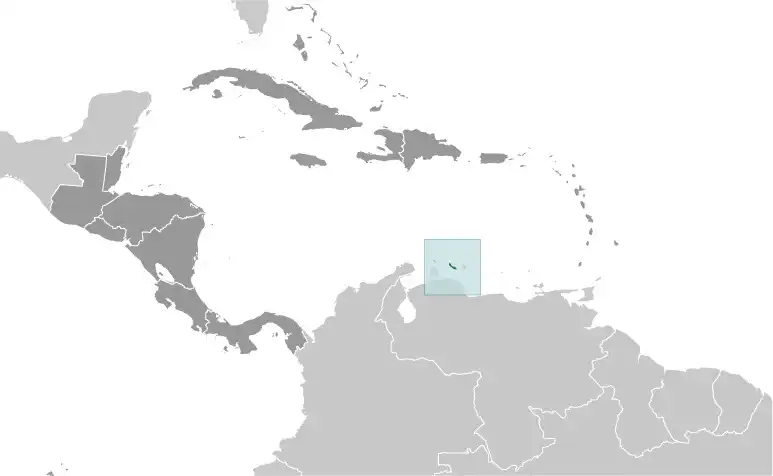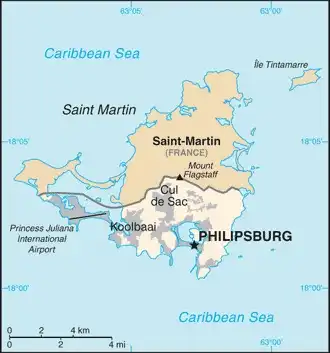
Sint Maarten
Veröffentlicht: 20. June 2022 - Letztes Update: 28. February 2025
Country Data Dashboard

Population
46,215
Growth: 1.15% (2024 est.)
GDP
$1.628 billion
(2023 est.)
Area
34 sq km
| Government type: | parliamentary democracy under a constitutional monarchy |
| Capital: | Philipsburg |
| Languages: | English (official) 67.5%, Spanish 12.9%, Creole 8.2%, Dutch (official) 4.2%, Papiamento (a Spanish-Portuguese-Dutch-English dialect) 2.2%, French 1.5%, other 3.5% (2001 est.) |
People & Society
Ethnicity (2011 est.)
Religion (2011 est.)
Age structure
No image available.
Economy
Economic overview
high-income, tourism-based Dutch autonomous constituent economy; severe hurricane- and COVID-19-related economic recessions; multilateral trust fund helping offset economic downturn; no property taxation; re-exporter to Saint Martin
Real GDP (purchasing power parity) in Billion $
Real GDP per capita in $
Exports & Imports in billion $
Top 5 Import Partner in 2022 (92%)
Top 5 Import Commodities in 2022
- refined petroleum ⛽
- jewelry 💍
- pearl products 🐚
- diamonds 💎
- cars 🚗
Top 5 Export Partner in 2022 (92%)
Top 5 Export Commodities in 2022
- gas turbines 🌀
- scrap iron 🛠️
- jewelry 💍
- coconuts/Brazil nuts/cashews 🌰
- flavored water 💧
Geography
Map

Area
Natural resources
- fish 🐟
- salt 🧂
Climate
tropical marine climate, ameliorated by northeast trade winds, results in moderate temperatures; average rainfall of 150 cm/year; hurricane season stretches from July to November
Historical Background Information
Christopher COLUMBUS claimed Saint Martin for Spain in 1493, naming it after the feast day of St. Martin of Tours, but it was the Dutch who occupied the island in 1631 to exploit its salt deposits. The Spanish retook Saint Martin in 1633, but the Dutch continued to assert their claims. The Spanish finally relinquished the island to the French and Dutch, who divided it between themselves in 1648. The border frequently fluctuated over the next 200 years because of friction between the two countries, with the Dutch eventually holding the smaller portion of the island (about 39%) and adopting the Dutch spelling of the island's name for their territory.
The establishment of cotton, tobacco, and sugar plantations dramatically expanded African slavery on the island in the 18th and 19th centuries; the practice was not abolished in the Dutch half until 1863. The island's economy declined until 1939 when it became a free port; the tourism industry was dramatically expanded beginning in the 1950s. In 1954, Sint Maarten and several other Dutch Caribbean possessions became part of the Kingdom of the Netherlands as the Netherlands Antilles. In a 2000 referendum, the citizens of Sint Maarten voted to become a self-governing country within the Kingdom of the Netherlands, effective in 2010. In 2017, Hurricane Irma hit Saint Martin/Sint Maarten, causing extensive damage to roads, communications, electrical power, and housing; the UN estimated that 90% of the buildings were damaged or destroyed.
The establishment of cotton, tobacco, and sugar plantations dramatically expanded African slavery on the island in the 18th and 19th centuries; the practice was not abolished in the Dutch half until 1863. The island's economy declined until 1939 when it became a free port; the tourism industry was dramatically expanded beginning in the 1950s. In 1954, Sint Maarten and several other Dutch Caribbean possessions became part of the Kingdom of the Netherlands as the Netherlands Antilles. In a 2000 referendum, the citizens of Sint Maarten voted to become a self-governing country within the Kingdom of the Netherlands, effective in 2010. In 2017, Hurricane Irma hit Saint Martin/Sint Maarten, causing extensive damage to roads, communications, electrical power, and housing; the UN estimated that 90% of the buildings were damaged or destroyed.
